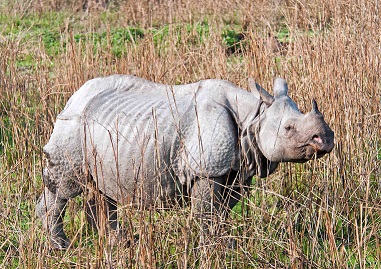Kaziranga National Park, Assam

Kaziranga National Park is located on the banks of the mighty Brahmaputra River in the far North East of India, Assam, and covers an area of approximately 430-sq-km with its swamps and tall thickets of elephant grass making it the ideal habitat for the Indian One-Horned Rhino. Due to the limitless poaching of this prehistoric survivor, the Kaziranga National Park has declared a wildlife sanctuary in 1940.
Major Wildlife Attractions of Kaziranga Wildlife Sanctuary
Besides of course the great one-horned Indian Rhino, the other major wild attractions include a large population of Indian Elephants, Indian Bison, Swamp Deer or Barasingha, Hog Deer, Sloth Bears, Tigers, Leopard Cats, Jungle Cats, Otters, Hog Badgers, Capped Langurs, Hoolock Gibbons, Wild Boar, Jackal, Wild Buffalo, Pythons, Monitor Lizards, etc.
Suggested Read: Assam – Culture, and Tradition
Kaziranga National Park is a birding paradise; the grasslands are a raptor country that can be seen on safari makes a remarkable experience. These include the Oriental Honey Buzzard, Black-Shouldered Kite, Black Kite, Brahminy Kite, Pallas’s Fishing Eagle, White Tailed Eagle, Grey-Headed Fishing Eagle, Himalayan Griffon, etc. Huge numbers of migratory birds descend on the parks lakes and marshy areas during winters, including Greylag Geese, Bar-Headed Geese, Ruddy Shelduck, Gadwall, Falcated Duck, Red-Crested Pochard and Northern Shoveller.

Other Attractions In Kaziranga
Elephant Safari: The vast open country makes Kaziranga National Park very accessible and wildlife viewing fairly pleasurable. Here one can leave in the early hours of the dawn for an elephant-back-ride. Authorized and trained Mahouts who guide visitors through the park train the Elephants. One could see wild Elephant herds roaming around or Indian Rhinos browse past visitors unconcernedly. Since Kaziranga wildlife Sanctuary is easily accessible, it provides a chance to see animals in the wild at such close quarters, thus making a trip to this National Park a very rewarding experience.
Suggested Read: Manas National Park
Sightseeing in Kaziranga: Tourists can stroll through the lush coffee and rubber plantations of the nearby Karbi Anglong. Or visit the Karbi villages, meet the Karbi people and observe their way of living. You can also venture through the tea gardens that Assam is so famous for and watch how one gets one’s daily cup of tea. Film shows on wildlife can be arranged at the various tourist lodges in Kaziranga, on request.
Best Time to Visit Kaziranga National Park
Kaziranga’s visiting season is from mid-November to early April months. During the monsoons, the Brahmaputra River bursts its banks, flooding the low-lying grasslands and causing animals to migrate from one area to another within the Kaziranga National Park.
How to Get there
Air: The nearest airport is situated at Guwahati, which is 217-km away from the park. The other airport is located at Jorhat, 97-km from Kaziranga.
Rail: The nearest railhead is Furkating, situated 75-km away from Kaziranga National Park.
Road: The main gate for Kaziranga Wildlife Sanctuary, at Kohora on the NH-37, consists of a handful of cafes and a small local market. ASTC and private buses stop here on their way to and from Guwahati, Tezpur, and Upper Assam. Some private buses also retain a seat quota for Kaziranga passengers.
Suggested Read: Me-dam-me-phi
General Info / Tips
Note: Visiting Kaziranga independently can be expensive due to the two-tier price system, with different entry costs for Indian nationals and foreigners. There are separate charges for elephant safari and jeep rides from the lodges to the park entrance, as well as a system of variable camera fees.
Suggested Read: Nicknames of Indian States
